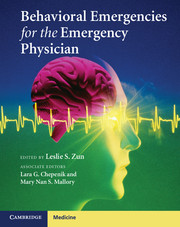Book contents
- Behavioral Emergencies for the Emergency Physician
- Behavioral Emergencies for the Emergency Physician
- Copyright page
- Contents
- Contributors
- Preface
- Section 1. General considerations for psychiatric care in the emergency department
- Section 2. Evaluation of the psychiatric patient
- Section 3. Psychiatric illnesses
- Section 4. Treatment of the psychiatric patient
- Section 5. Special populations
- Chapter 29 Pediatric psychiatric disorders in the emergency department
- Chapter 30 Geriatric psychiatric emergencies
- Chapter 31 Disaster and terrorism emergency psychiatry
- Chapter 32 Trauma and loss in the emergency setting
- Chapter 33 Management ofhomeless and disadvantaged persons in the emergency department
- Chapter 34 Management of neurobehavioral sequelae oftraumatic brain injury in the emergency department
- Chapter 35 Management of psychiatric illness inpregnancy in the emergency department
- Chapter 36 Cultural concerns and issues in emergency psychiatry
- Chapter 37 Rural emergency psychiatry
- Section 6. Administration of psychiatric care
- Index
Chapter 31 - Disaster and terrorism emergency psychiatry
from Section 5. - Special populations
Published online by Cambridge University Press: 05 April 2013
- Behavioral Emergencies for the Emergency Physician
- Behavioral Emergencies for the Emergency Physician
- Copyright page
- Contents
- Contributors
- Preface
- Section 1. General considerations for psychiatric care in the emergency department
- Section 2. Evaluation of the psychiatric patient
- Section 3. Psychiatric illnesses
- Section 4. Treatment of the psychiatric patient
- Section 5. Special populations
- Chapter 29 Pediatric psychiatric disorders in the emergency department
- Chapter 30 Geriatric psychiatric emergencies
- Chapter 31 Disaster and terrorism emergency psychiatry
- Chapter 32 Trauma and loss in the emergency setting
- Chapter 33 Management ofhomeless and disadvantaged persons in the emergency department
- Chapter 34 Management of neurobehavioral sequelae oftraumatic brain injury in the emergency department
- Chapter 35 Management of psychiatric illness inpregnancy in the emergency department
- Chapter 36 Cultural concerns and issues in emergency psychiatry
- Chapter 37 Rural emergency psychiatry
- Section 6. Administration of psychiatric care
- Index
Summary
Keywords
- Type
- Chapter
- Information
- Behavioral Emergencies for the Emergency Physician , pp. 230 - 234Publisher: Cambridge University PressPrint publication year: 2013



